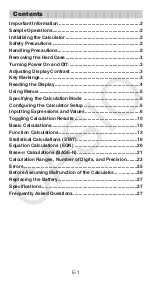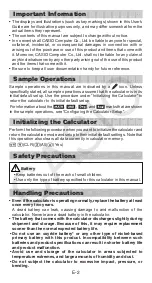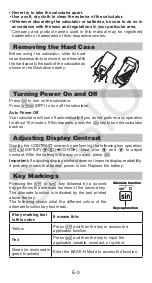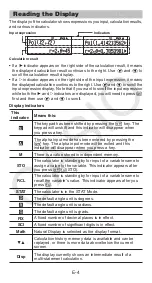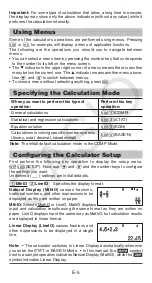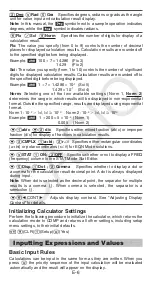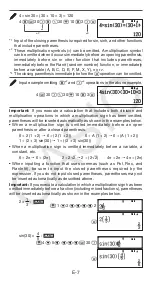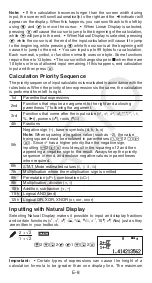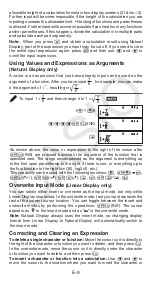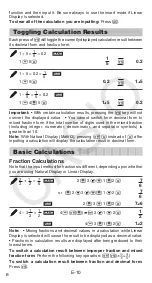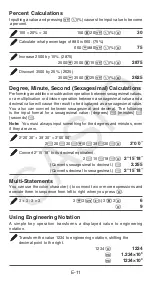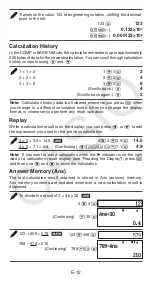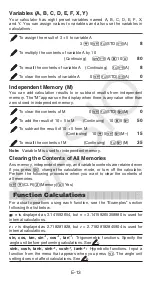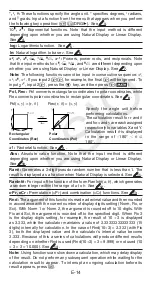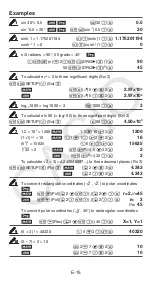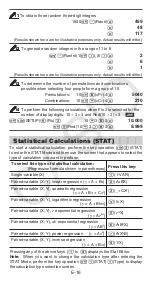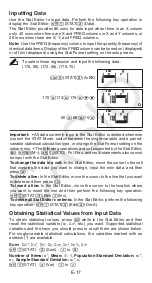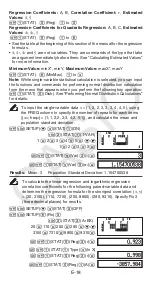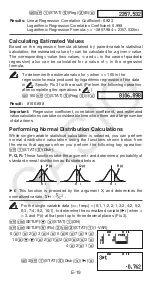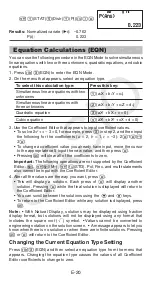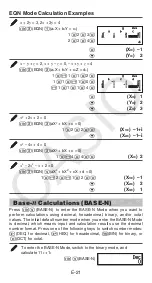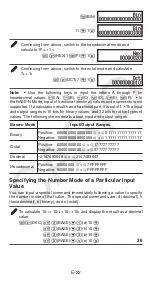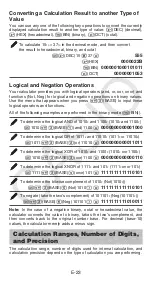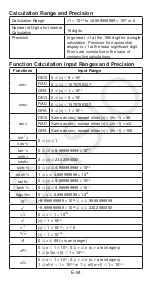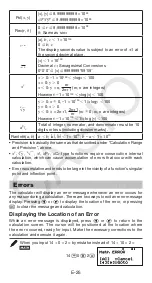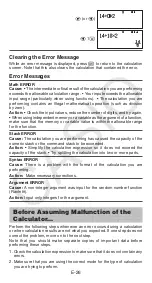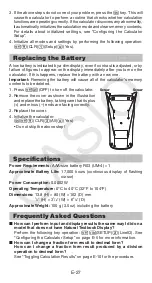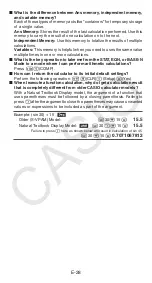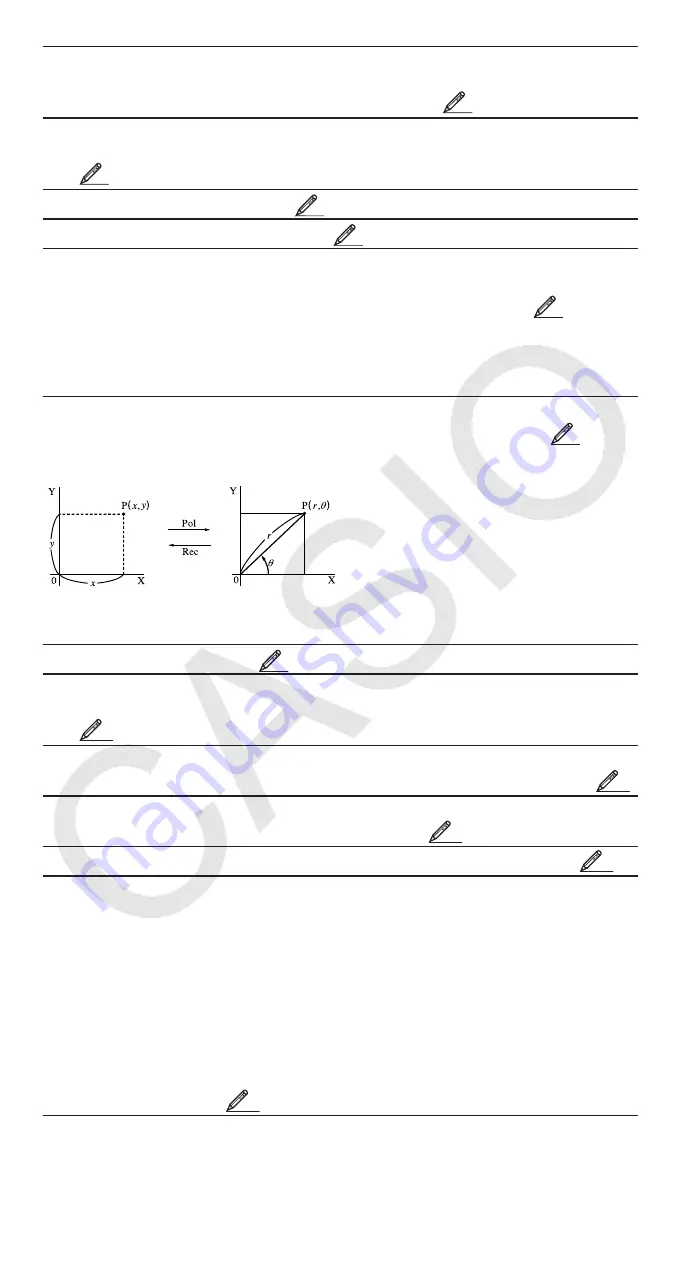
E-14
°,
r
,
g
:
These functions specify the angle unit. ° specifies degrees,
r
radians,
and
g
grads. Input a function from the menu that appears when you perform
the following key operation:
1G
(DRG
'
). See
3
.
$
,
%
:
Exponential functions. Note that the input method is different
depending upon whether you are using Natural Display or Linear Display.
See
4
.
log
:
Logarithmic function. See
5
.
ln
:
Natural logarithm to base
e
. See
6
.
x
2
,
x
3
,
x
^
,
)
,
#
,
"
,
x
−1
:
Powers, power roots, and reciprocals. Note
that the input methods for
x
^
,
)
,
#
, and
"
are different depending upon
whether you are using Natural Display or Linear Display. See
7
.
Note:
The following functions cannot be input in consecutive sequence:
x
2
,
x
3
,
x
^
,
x
−1
. If you input 2
ww
, for example, the final
w
will be ignored. To
input 2
2
2
, input 2
w
, press the
d
key, and then press
w
(
B
).
Pol, Rec
:
Pol converts rectangular coordinates to polar coordinates, while
Rec converts polar coordinates to rectangular coordinates. See
8
.
Pol(
x
,
y
) = (
r
,
) Rec(
r
,
) = (
x
,
y
)
Specify the angle unit before
performing calculations.
The calculation result for
r
and
and for
x
and
y
are each assigned
respectively to variables X and Y.
Calculation result
θ
is displayed
in the range of −180°
θ
180°.
Rectangular
Coordinates (Rec)
Polar
Coordinates (Pol)
x
!
:
Factorial function. See
9
.
Abs
:
Absolute value function. Note that the input method is different
depending upon whether you are using Natural Display or Linear Display.
See
10
.
Ran#
:
Generates a 3-digit pseudo random number that is less than 1. The
result is displayed as a fraction when Natural Display is selected. See
11
.
RanInt#
:
For input of the function of the form RanInt#(
a
,
b
), which generates
a random integer within the range of
a
to
b
. See
12
.
n
P
r
,
n
C
r
:
Permutation (
n
P
r
) and combination (
n
C
r
) functions. See
13
.
Rnd
:
The argument of this function is made a decimal value and then rounded
in accordance with the current number of display digits setting (Norm, Fix, or
Sci). With Norm 1 or Norm 2, the argument is rounded off to 10 digits. With
Fix and Sci, the argument is rounded off to the specified digit. When Fix 3
is the display digits setting, for example, the result of 10 ÷ 3 is displayed
as 3.333, while the calculator maintains a value of 3.33333333333333 (15
digits) internally for calculation. In the case of Rnd(10÷3) = 3.333 (with Fix
3), both the displayed value and the calculator’s internal value become
3.333. Because of this a series of calculations will produce different results
depending on whether Rnd is used (Rnd(10÷3)
×
3 = 9.999) or not used (10
÷ 3
×
3 = 10.000). See
14
.
Note:
Using functions can slow down a calculation, which may delay display
of the result. Do not perform any subsequent operation while waiting for the
calculation result to appear. To interrupt an ongoing calculation before its
result appears, press
A
.


